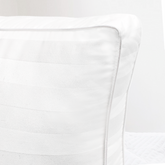When creating and curating a well-designed home, it’s easy to focus all our attention on what we see. Since sight is one of our most powerful senses, it’s no wonder that the visual experience of a space is also the one that first comes to mind – colors, patterns, lighting, shapes, etc. But it’s not just about choosing color palettes or creating focal points with interesting objects or either natural or artificial light. For example, the arrangement of furniture can also be used to stimulate our visual sense and provide important information to our brains about our environment (and our place within it). These work together to make a space feel spacious, comfortable, calming – or whatever other feeling we want to evoke.

However, it’s important not to overlook our other four senses – touch, sound, taste, and smell – and the role they also play in home design. Your senses interpret the world at every moment, influencing your feelings, affecting your wellbeing, and playing a profound role in the creation of memories. So when you walk into any environment, you experience the space with every one of your senses alert in your body and receiving information that your brain processes into a complete, enriching experience. It’s the combination of all our five senses working together in harmony that adds depth and dimension to a design, ultimately creating a beautiful home and contributing greatly to that ‘love coming home’ feeling.

But how can you make each of your senses work for you? Start with this process outlined in Jennifer’s book, Love Coming Home:
- Walk through your home, paying close attention to the non-visual elements that make up each room in your home – the smells, feelings, tastes, and sounds that are part of the experience. For example, you might ask yourself: “What is it I hear?”, then pay close attention to every sound. Close your eyes and be mindfully present to all the sounds, smells, textures, and tastes around you.
- Not every sensory experience is a positive one. Did you identify anything you didn’t like during your exploration of the space? How could you change it?
- Use your five senses to mindfully evaluate your possessions. Consider if each object supports the environment you want to create and fully experience for yourself and your family. If not, it’s time to let it go.

Want to add more sensory layers to your home? Here are some easy ways to enhance a space.
Touch. Texture is a key factor when choosing your home décor as different textures can completely change the feel of a room. Think about the difference between cozy carpet and polished wood floors, for example, or between leather and plush fabrics on a couch. Try to incorporate a variety of textures throughout your home and feel free to change things up with the seasons using throws, pillows, rugs, different bed linens, and so on.
Taste. Engaging with the sense of taste is a little less straightforward, but the key is to introduce elements that evoke taste memories. For example, a bowl of fruit immediately reminds us of the taste of that fruit. Color can also be important as certain hues have been shown to increase appetite, such as red or orange. Including pops of these colors in your kitchen or dining room can add to the experience of cooking and eating there.
Smell. Some scents will emerge naturally in your home – for example, the scent of certain types of wooden furniture, particular plants outside an open window, and the waft of homemade cooking or baking. But you can also add scent cues to a space in an intentional way. The important thing is to keep these aromas natural and subtle as too much can be overwhelming. For example, fill your home with fragrant fresh flowers and plants like lavender or rosemary. Plant jasmine outside a window or place geraniums in a window pot. Scented candles or oil diffusers are also a calming and evocative addition. It’s also important to open windows in your home to allow scents like cut grass and fresh air in, while also clearing stale or unpleasant smells through good air flow.
Sound. Background sounds can have a wonderfully calming effect, and set the tone for a space. Of course, music is an important part of this, but there are other ways to add calming sounds without pressing play. For example, a small fountain adds the soothing sound of water, while a wind chime adds a pretty, summery note to a home. On the other hand, if you live in a busy place, it’s a good idea to invest in soundproofing so that you can eliminate or reduce the sound of traffic.

You can learn more about using your senses to design and transform your home, and other practical tips, from Jennifer’s book, Love Coming Home.






